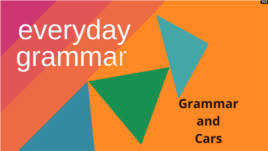20 April 2023
Imagine you are in a car. Perhaps another person is driving. What kinds of sentences are you likely to hear or use?
In today's Everyday Grammar, we will show you how cars can teach you about English grammar. You will learn about common sentence structures that are used while driving. We will also make some car comparisons to help you remember grammar points.
Let's start with a few important ideas about sentences.

Everyday Grammar
Ideas
A car is a vehicle for getting people or goods across an area.
We can think of a sentence as a vehicle for getting information across to other people.
Just as there are different kinds of cars – vans, trucks, sports cars, and so on – there are also different kinds of sentences.
Some sentences might be used for special purposes - just as a car might be used for a special purpose.
We will now consider two sentence types that are commonly used while driving in cars: imperative sentences and exclamatory sentences.
Imperatives
A quick reminder about sentences. Complete sentences involve a subject and a predicate.
But some kinds of sentences only suggest the subject.
One example is the imperative sentence, commonly used to give driving instructions or directions.
The imperative sentence generally only consists of a predicate. The predicate often has the base form of the verb as well as additional information.
Let's imagine that you are riding in a car. You are in the passenger seat, and someone else is driving.
Person 1: Which way should I turn?
Person 2: Turn left at the stop sign.
Here, we have the imperative "turn left at the stop sign." The sentence involves the base form of the verb "turn" along with the direction "left." We also have the phrase "at the stop sign."
We use imperatives to give all kinds of instructions when riding in a car. For example, you might say "start the car," "park the car," "speed up," "slow down," "put on the parking brake," and so on.
Exclamatory sentences
Now, let's turn our attention to a second kind of sentence you are likely to hear or use when driving: exclamatory sentences.
Grammar books describe exclamatory sentences in terms of emotion and in terms of word order. Let's explore both of these in turn.
The first way we describe exclamatory sentences is in terms of emotion. In other words, exclamatory sentences can be any kind of sentence that is spoken with more emotion. And when we are driving, that emotion is often – but not always – negative.
For example:
"I can't believe he cut me off!"
The second kind of exclamatory sentence involves a change of word order. We often use "what" or "how" in these kinds of statements. We also often leave out the verb.
Imagine you are on a peaceful drive on a beautiful fall day. The trees are red, orange, and yellow. You might say,
"What a lovely day! "
Now imagine you are stuck in heavy traffic. A person speeds up and cuts in front of you. You might say in a negative tone:
"What a piece of work!"
Or something like this:
"What the -----!"
This kind of exclamatory sentence is not polite, and we do not suggest using it. But you might hear it or something like it in a film or in real life.
Putting it together
We have explored two kinds of sentences: imperative sentences and exclamatory sentences.
You might compare imperative sentences to race cars. Race cars are about speed and quickness. So they might not have some parts that weigh them down.
Similarly, imperatives are about speed and quickness in communication. Imperatives are reduced to simple elements – the predicate with the base form of the verb.
We also explored two kinds of exclamatory statements. Exclamatory sentences suggest colorful emotions. We might compare exclamatory statements to colorful cars – bright yellow, deep orange, brilliant red.
Of course, none of these comparisons are perfect. But they can give you a general way to remember ideas about different kinds of sentences.
I'm John Russell.
John Russell wrote this lesson for VOA Learning English.
________________________________________________________________
Words in This Story
imperative – n. the form that a verb or sentence has when it is expressing a command
exclamatory – adj. describes a word, phrase, or sound that expresses a strong emotion
predicate – n. the part of a sentence that expresses what is said about the subject
phrase – n. a group of two or more words that express a single idea but do not usually form a complete sentence
negative – adj. harmful or bad : not wanted